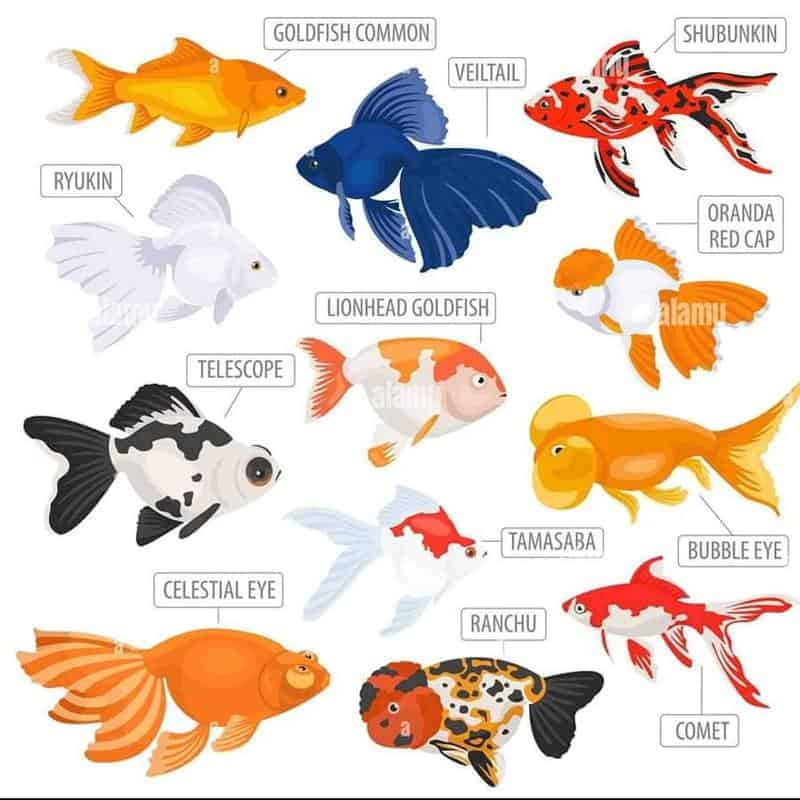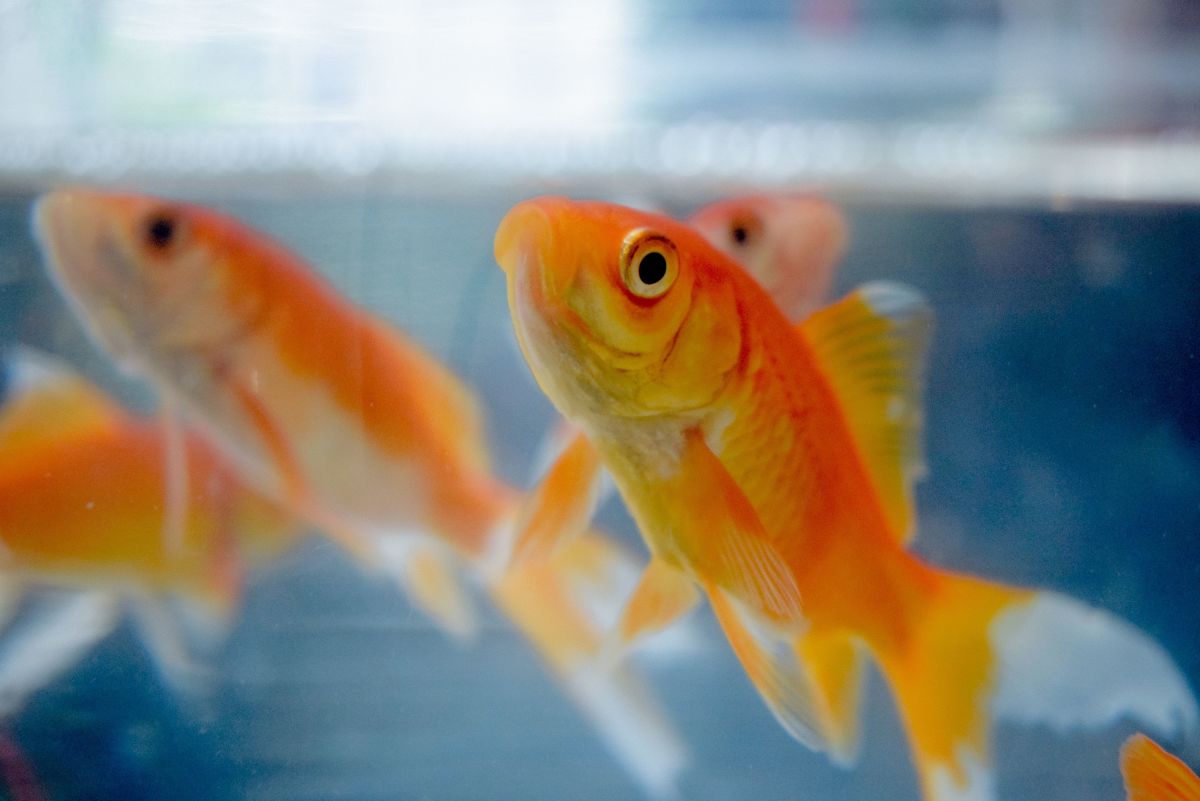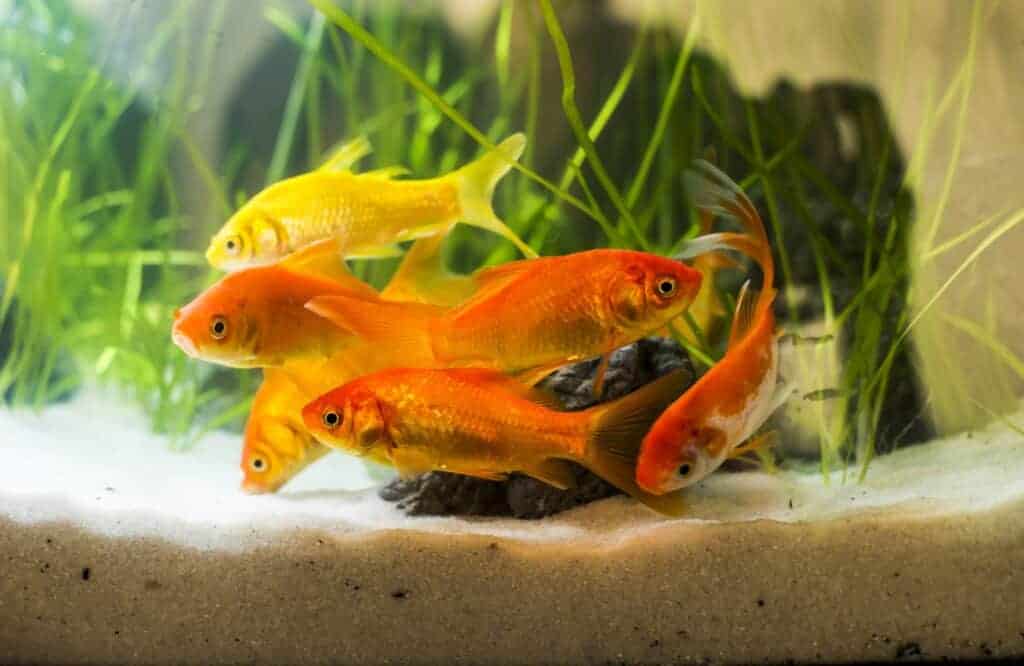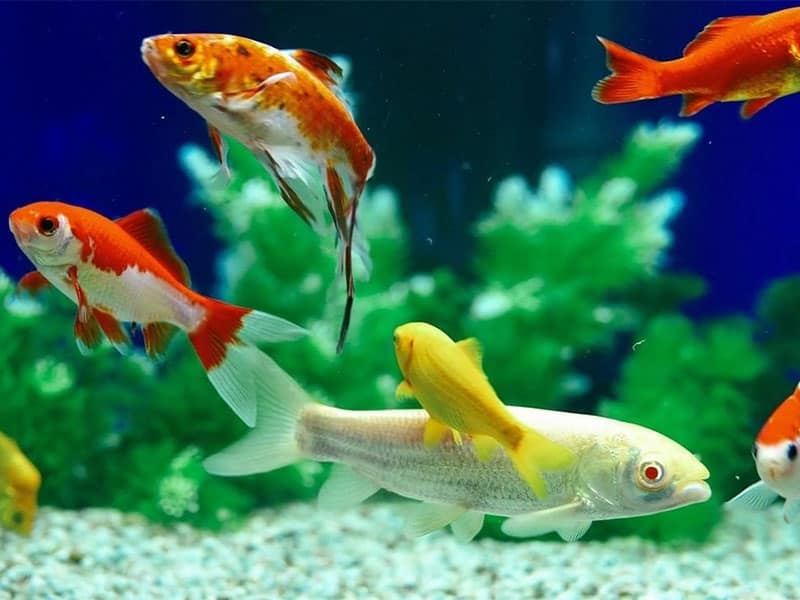Have you ever wondered if you can mix different types of goldfish? Well, I've got good news for you - you absolutely can! Goldfish come in a wide variety of shapes, sizes, and colors, and mixing different types can create a stunning and visually appealing aquarium. Whether you have a fancy goldfish like a Oranda or a Comet goldfish, it's totally possible to keep them together and enjoy their unique characteristics. In this article, I'll explain the factors to consider when mixing different types of goldfish and provide some practical tips to ensure their compatibility and well-being. So, let's dive in and learn more about this exciting aspect of goldfish keeping!
When it comes to mixing different types of goldfish, it's essential to consider their individual needs and compatibility. While goldfish are generally adaptable, it's important to select types that have similar requirements in terms of water temperature, pH level, and diet. This will ensure that all the goldfish in your tank thrive and remain healthy. Additionally, it's important to consider the size of the tank or pond. Goldfish require ample swimming space, so it's crucial to provide enough room for all the fish to move around comfortably.
Now, let's talk about the different types of goldfish that you can mix. With their stunning colors and unique features, fancy goldfish like Oranda, Ranchu, and Ryukin can be mixed together to create a visually captivating aquarium. These fancy goldfish have double tails, vibrant colors, and a distinct body shape, which can make for a delightful underwater display. Alternatively, you can mix single-tail goldfish like Comet and Shubunkin, which are known for their gracefulness and agility in the water. By combining these different types of goldfish, you can create a diverse and visually dynamic aquatic environment.
In conclusion, mixing different types of goldfish is absolutely possible and can result in a stunning and visually appealing aquarium or pond. However, it's important to consider their individual needs, such as water temperature, pH level, and diet, to ensure their compatibility and well-being. Additionally, providing sufficient swimming space is crucial for goldfish to thrive. So, if you're ready to take your goldfish keeping to the next level, go ahead and mix different types of goldfish to create your own underwater masterpiece.

Can I Mix Different Types Of Goldfish
If you are a goldfish enthusiast or considering getting goldfish as pets, you may have wondered whether it is possible to mix different types of goldfish together in the same tank. Goldfish come in a variety of shapes, sizes, and colors, each with its own unique characteristics. Mixing different types of goldfish can create a visually stunning aquarium, but it also requires careful consideration of compatibility and proper management. In this article, we will explore the types of goldfish, discuss compatibility factors to consider, and provide guidance on mixing and managing different types of goldfish.
Types of Goldfish
Goldfish are known for their vibrant colors, flowing fins, and unique body shapes. There are several popular types of goldfish, each with its own distinct features and characteristics. Let's explore some of the most common types:
Common Goldfish
The common goldfish, also known as the slim-bodied goldfish, is one of the most widely recognized types. It has a streamlined body, single tail fin, and can grow to a considerable size. Common goldfish are usually gold or orange in color and can live for many years if properly cared for.
Comet Goldfish
Comet goldfish are similar in appearance to common goldfish but have longer, more slender bodies and two distinct tail lobes. They are known for their agility and swimming capabilities, making them an active and lively addition to any aquarium.
Shubunkin Goldfish
Shubunkin goldfish are easily recognizable by their calico-patterned scales, which can vary in color and pattern. They have a single tail fin and a slightly stouter body compared to common or comet goldfish. Shubunkins are known for their hardiness and adaptability to different water conditions.
Fantail Goldfish
Fantail goldfish have a double tail fin, giving them a stunning fan-shaped appearance. They have a rounded body and come in a variety of colors. Fantails are a popular choice for goldfish enthusiasts due to their elegant appearance and peaceful nature.
Oranda Goldfish
Oranda goldfish are famous for their unique appearance, characterized by a prominent fleshy growth on their heads called a wen. They have a rounded body shape and their long flowing fins add to their overall beauty. Orandas require a carefully maintained tank due to their sensitive wen growth.
Ryukin Goldfish
Ryukin goldfish have a similar body shape to fantails but have a more triangular, humpback appearance. They can have either a single or double tail fin and come in various colors. Ryukins are known for their active nature and graceful swimming style.
Telescope Goldfish
Telescope goldfish are instantly recognizable due to their distinctive protruding eyes, which resemble miniature telescopes. They have a round body shape and flowing fins. Telescopes require extra care as their vision is impaired by their unique eye shape.
Bubble Eye Goldfish
Bubble Eye goldfish are known for the fluid-filled sacs underneath their eyes, which give them a whimsical appearance. They have a rounded body and double tail fins. Bubble Eye goldfish require a gentle environment to prevent their sacs from getting damaged.
Lionhead Goldfish
Lionhead goldfish have a prominent head growth called a hood or wen, similar to the Oranda goldfish. However, the lionhead has a more compact and rounded body shape. They are highly sought after for their unique appearance.
Pearlscale Goldfish
Pearlscale goldfish have distinctive scales that resemble pearls, giving them a beautiful and unique look. They have a rounded body with a double tail fin. Pearlscales can be more delicate than other goldfish types, so they require careful monitoring and care.
Compatibility of Goldfish
When considering mixing different types of goldfish, it is essential to understand compatibility factors. Compatibility involves assessing whether the different goldfish types can coexist peacefully based on size, water parameter preferences, and behavioral traits. Proper compatibility ensures a harmonious and stress-free environment for all the goldfish in the tank.
Understanding Compatibility
Compatibility is crucial because some goldfish types may be more aggressive or territorial than others. It is essential to choose goldfish types that have similar temperaments and are not likely to cause conflict or stress among themselves. Additionally, compatibility ensures that all goldfish have access to food and resources in the tank.
Size Compatibility
Size compatibility is an important consideration as some goldfish types can grow significantly larger than others. It is generally not recommended to mix goldfish of significantly different sizes, as larger goldfish may consider smaller ones as prey or may inadvertently cause injury due to their size. Ensuring that goldfish types have similar growth rates and adult sizes can help prevent size-related conflicts.
Water Parameter Compatibility
Goldfish have specific water parameter requirements, including temperature, pH, and water hardness. It is important to choose goldfish types that have similar water parameter preferences to avoid stress or health issues. Matching the water conditions to suit all the goldfish types ensures a comfortable and suitable environment for all.
Behavioral Compatibility
Behavioral compatibility is another crucial aspect to consider when mixing goldfish types. Some goldfish types may be more active or aggressive, while others may be calmer or more docile. It is important to choose goldfish types that have similar behavioral tendencies to prevent bullying or aggression. Observing the behavior of individual goldfish before mixing them can help determine their compatibility.
Mixing Goldfish Types
Once you have considered compatibility factors, you can begin the process of mixing different types of goldfish together in the same tank. Mixing goldfish types can have several benefits, including enhancing aesthetic appeal, utilizing different behavior traits, and creating a diverse ecosystem. However, it is crucial to follow certain guidelines and avoid certain combinations to ensure a successful and harmonious community of goldfish.
Mixing Compatible Types
Choosing goldfish types that have similar temperament, size potential, and water parameter preferences is the key to mixing compatible types. For example, common and comet goldfish are often compatible due to their similar body shapes, sizes, and hardiness. Fantails, Orandas, and Ryukins can also coexist peacefully due to their gentle nature and similar water parameter requirements. It is essential to research and seek advice from experts to determine compatible goldfish types for mixing.
Avoiding Incompatible Types
Certain goldfish types may have characteristics that make them incompatible with others. For example, Telescope goldfish have impaired vision, which can make them vulnerable to aggression from more active or nippy goldfish types. Bubble Eye goldfish have delicate fluid-filled sacs that can be easily damaged, making them more susceptible to injury. It is best to avoid mixing incompatible types to prevent stress, injury, or potential health issues.

Benefits of Mixing Goldfish Types
Mixing different types of goldfish can offer several benefits in terms of aesthetic appeal, behavior traits, and creating a diverse ecosystem in the tank.
Enhanced Aesthetic Appeal
Mixing goldfish types can create a visually stunning aquarium with a variety of colors, body shapes, and fin types. The contrasting features of different goldfish types can transform a tank into a captivating centerpiece. Whether it's the flowing fins of Fantails or the unique head growth of Orandas, a mixed goldfish community can be a delightful sight to behold.
Utilizing Different Behavior Traits
Each goldfish type has its own distinct behavior traits. Mixing goldfish types allows for the utilization of these traits to create a dynamic and engaging aquarium. For example, choosing more active goldfish types like comet or shubunkin goldfish can add energy and movement to the tank, while calmer goldfish types like fantails or orandas can provide a sense of tranquility.
Creating a Diverse Ecosystem
Mixing different types of goldfish can create a diverse ecosystem within the tank. Each goldfish type has its own role and contribution to the overall ecosystem. Some goldfish may prefer to graze on vegetation, while others may actively swim around in search of food. This diversity can create a balanced and self-sustaining ecosystem, enhancing the overall health and vitality of the tank.
Considerations When Mixing Goldfish Types
While mixing goldfish types can be rewarding, it requires careful consideration and management to ensure the well-being of the goldfish.
Tank Size and Setup
The tank size and setup play a crucial role in maintaining a mixed goldfish community. Goldfish require ample space to swim and thrive. It is important to provide a tank size that accommodates the growth potential and activity levels of the goldfish types being mixed. Additionally, the tank setup should include hiding spots, live plants, and sufficient filtration to meet the needs of all goldfish.
Feeding and Nutrition
Goldfish have specific dietary requirements, and it is essential to ensure that all goldfish in the tank receive adequate nutrition. Choosing a high-quality goldfish food that provides a balanced diet is recommended. Additionally, monitoring feeding time and ensuring all goldfish have equal access to food can prevent aggression or bullying during meal times.
Monitoring Fish Health
Regular monitoring of fish health is essential when mixing goldfish types. Any signs of illness or stress should be addressed promptly to prevent the spread of disease within the tank. It is recommended to have a quarantine tank available to isolate sick or injured goldfish for treatment and recovery.
Monitoring Goldfish Interaction
Once you have mixed different types of goldfish together, it is important to monitor their interaction and behavior to ensure a harmonious community.
Observing Aggression or Bullying
Some goldfish types may display aggressive behavior towards others, leading to bullying or stress. It is important to observe the interactions between goldfish closely and intervene if necessary. Signs of aggression include fin nipping, chasing, or constantly displacing other goldfish. Addressing aggressive behavior promptly can help maintain a peaceful environment.
Ensuring Equal Access to Food
When mixing goldfish types, it is important to ensure that all goldfish have equal access to food. Some goldfish types may be faster eaters or more dominant during feeding time, causing others to miss out on essential nutrition. Adding multiple feeding spots or using sinking pellets can help ensure that all goldfish receive their fair share of food.
Monitoring for Disease Spread
When goldfish are mixed together, there is a potential for disease transmission if one goldfish becomes sick. It is important to monitor the health of all goldfish regularly and quarantine any sick individuals to prevent the spread of disease. Providing a clean and well-maintained environment can also help minimize the risk of disease outbreaks.
Managing Potential Challenges
Mixing different types of goldfish can come with its own set of challenges. Being prepared to address these challenges is crucial for maintaining a successful mixed goldfish community.
Dealing with Aggressive Behavior
If aggressive behavior occurs between goldfish types, it may be necessary to separate or rehome certain individuals to prevent harm to others. Providing ample hiding spots, visual barriers, or rearranging tank decorations can help diffuse aggression. In severe cases, consulting an aquatic specialist or experienced goldfish keeper may be necessary for further guidance.
Treating Diseases
If a goldfish becomes sick, prompt treatment is essential to prevent the spread of disease in the tank. Isolating the sick fish in a quarantine tank and treating it accordingly can help prevent further infection. Consulting a veterinarian or aquatic specialist for proper diagnosis and treatment is recommended.
Removing Incompatible Fish
If despite careful consideration, some goldfish types prove to be incompatible, it may be necessary to remove them from the tank. Incompatible goldfish can cause stress, injury, or overall disruption of the tank's ecosystem. Finding a suitable alternative home for the incompatible goldfish ensures their well-being and maintains the harmony of the tank.
Breeding Mixed Goldfish Types
Breeding goldfish can be a rewarding experience, but caution must be taken when breeding mixed goldfish types to prevent hybridization.
Understanding Hybridization
Hybridization occurs when goldfish of different types breed and produce offspring with mixed traits. While hybridization can result in visually striking offspring, it can also lead to genetic anomalies and health issues. Therefore, it is generally recommended to avoid intentionally breeding mixed goldfish types to preserve the integrity of each goldfish type.
Breeding Techniques
If you choose to breed goldfish, it is advisable to separate goldfish types during the breeding process to maintain purebred lines. This involves using breeding tanks or nets to separate males and females of specific goldfish types, allowing controlled breeding and preservation of unique traits. Seeking guidance from experienced breeders or experts can provide additional insights on proper breeding techniques.
Expert Advice on Mixing Goldfish
When considering mixing different types of goldfish, seeking advice from aquatic specialists or experienced goldfish keepers can provide valuable guidance.
Consulting an Aquatic Specialist
Aquatic specialists, such as veterinarians or biologists, have a wealth of knowledge regarding goldfish care and compatibility. They can assess specific situations and provide tailored advice on whether certain goldfish types can be mixed together safely.
Seeking Insights from Experienced Goldfish Keepers
Experienced goldfish keepers who have successfully mixed different goldfish types can provide practical insights and tips based on their firsthand experience. Engaging with online forums or joining goldfish enthusiast groups can connect you with knowledgeable individuals who can share their expertise.
Conclusion
Mixing different types of goldfish can create a visually stunning and diverse aquarium. By considering compatibility factors, appropriately managing tank size and setup, and monitoring goldfish interactions, you can create a harmonious community of goldfish. Remember to prioritize the well-being of the goldfish by providing them with suitable living conditions, a balanced diet, and prompt attention to any signs of illness or aggression. With proper care and attention, you can enjoy the beauty and excitement of a mixed goldfish community in your own home.


















